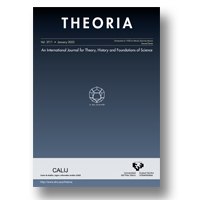|
monographic section |
|
21.
|
Theoria: An International Journal for Theory, History and Foundations of Science:
Volume >
37 >
Issue: 1
Jiji Zhang
On the unity between observational and experimental causal discovery
abstract |
view |
rights & permissions
| cited by
In “Flagpoles anyone? Causal and explanatory asymmetries”, James Woodward supplements his celebrated interventionist account of causation and explanation with a set of new ideas about causal and explanatory asymmetries, which he extracts from some cutting-edge methods for causal discovery from observational data. Among other things, Woodward draws interesting connections between observational causal discovery and interventionist themes that are inspired in the first place by experimental causal discovery, alluding to a sort of unity between observational and experimental causal discovery. In this paper, I make explicit what I take to be the implicated unity. Like experimental causal discovery, observational causal discovery also relies on interventions (or exogenous variations, to be more accurate), albeit interventions that are not carried out by investigators and hence need to be detected as part of the inference. The observational patterns appealed to in observational causal discovery are not only surrogates for would-be interventions, as Woodward sometimes puts it; they also serve to mark relevant interventions that actually happen in the data generating process.
|
|
|
|
|
22.
|
Theoria: An International Journal for Theory, History and Foundations of Science:
Volume >
37 >
Issue: 1
Kun Zhang
Computational causal discovery: Advantages and assumptions
abstract |
view |
rights & permissions
| cited by
I would like to congratulate James Woodward for another landmark accomplishment, after publishing his Making Things Happen: A Theory of Causal Explanation (Woodward, 2003). Makes Things Happens gives an elegant interventionist theory for understanding explanation and causation. The new contribution (Woodward, 2022) relies on that theory and further makes a big step towards empirical inference of causal relations from nonexperimental data. In this paper, I will focus on some of the emerging computational methods for finding causal relations from non-experimental data and attempt to complement Woodward’s contribution with discussions on 1) how these methods are connected to the interventionist theory of causality, 2) how informative the output of the methods is, including whether they output directed causal graphs and how they deal with confounders (unmeasured common causes of two measured variables), and 3) the assumptions underlying the asymptotic correctness of the output of the methods about causal relations. Different causal discovery methods may rely on different aspects of the joint distribution of the data, and this discussion aims to provide a technical account of the assumptions.
|
|
|
|
|
23.
|
Theoria: An International Journal for Theory, History and Foundations of Science:
Volume >
37 >
Issue: 1
Porter Williams
The fate of causal structure under time reversal
abstract |
view |
rights & permissions
| cited by
What happens to the causal structure of a world when time is reversed? At first glance it seems there are two possible answers: the causal relations are reversed, or they are not. I argue that neither of these answers is correct: we should either deny that time-reversed worlds have causal relations at all, or deny that causal concepts developed in the actual world are reliable guides to the causal structure of time-reversed worlds. The first option is motivated by the instability under intervention of time-reversed dynamical evolutions. The second option is motivated by a recognition of how contingent structural features of the actual world shape, and license the application of, our causal concepts and reasoning strategies.
|
|
|
|
|
24.
|
Theoria: An International Journal for Theory, History and Foundations of Science:
Volume >
37 >
Issue: 1
Fernanda Samaniego
Bi-directionality in causal relationships
abstract |
view |
rights & permissions
| cited by
This paper aims to provide an answer to James Woodward’s article “Flagpoles anyone? Causal and explanatory asymmetries”. It will be conjectured that, when causal directionality depends on the experimental design, it is because the variables involved are capable of producing changes in each other. This will be exemplified using the case of ideal gases as opposed to the flagpole-shadow scenario.
|
|
|
|
|
25.
|
Theoria: An International Journal for Theory, History and Foundations of Science:
Volume >
37 >
Issue: 1
James Woodward
Responses
view |
rights & permissions
| cited by
|
|
|
|
|
|
|
26.
|
Theoria: An International Journal for Theory, History and Foundations of Science:
Volume >
37 >
Issue: 1
Summary
view |
rights & permissions
| cited by
|
|
|
|
